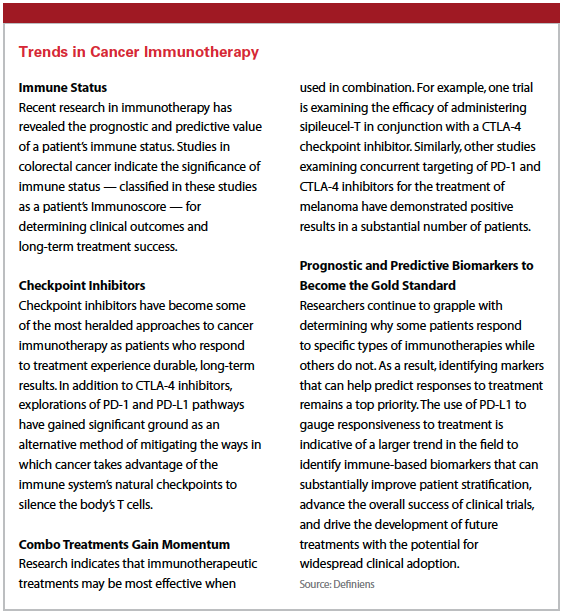Enabling Cancer Immunotherapies
 Henry Li, Ph.D., VP, Translational Oncology at Crown Bioscience, talks about the challenges of developing new and novel cancer immunotherapeutics.
Henry Li, Ph.D., VP, Translational Oncology at Crown Bioscience, talks about the challenges of developing new and novel cancer immunotherapeutics.
PV: Cancer immunotherapy is a hot area of research now. Why do you think this is?
Li: Cancer chemotherapies are toxic agents. Sometimes it is the drug — not the cancer — that dramatically weakens a patient. Immunotherapies have advantages over chemotherapies, because immunotherapies specifically target the disease and so the toxicity is usually less, and the effect of the therapy is throughout the whole body, so it isn’t limited to a certain location. Additionally, the immune system has memory, so if a tumor tries to come back, the immunotherapy is reactivated against the cancer, which is not possible with other therapies.
Immunotherapy has opened up possibilities for new treatments. In the last few decades, we’ve made progress in treating many cancers, but in many others we haven’t.
PV: What are the challenges for developing immunotherapies?
Li: One of the challenges is the lack of animal models. To engraft a human tumor tissue into a mouse, the mouse cannot have an immune system. If the mouse has an immune system, the human tissue will be rejected. Using mice is a commonly used model for cancer, but it’s not a very useful model for studying cancer immunotherapies.
an immune system. If the mouse has an immune system, the human tissue will be rejected. Using mice is a commonly used model for cancer, but it’s not a very useful model for studying cancer immunotherapies.
One alternative is to use a mouse tumor instead of the human tissue. And there are models available for this surrogate testing system. But current animal models often fail to accurately identify immunotherapies with the greatest clinical potential and there is a need for reliable preclinical tools to test these drugs directly against human cancers.
Another challenge is the small number of patients who respond to immunotherapies. When they work, they work great. But we don’t know who is likely to respond, and we don’t why they respond and others don’t.
With oncology it’s easy to think about combination therapies, but this presents another challenge. With immunotherapies, the question is what to combine them with because there are so many cancer agents on the market and in development. Also, trials with combined agents may present additional complexities and risks to the drug sponsor and the patient. We will gain more knowledge as we develop more immunotherapies. Since the PD-1 inhibitors became available, many researchers are now trying to combine other therapies with these for various cancers. (Editor’s Note: Merck’s Keytruda, approved in September 2014, and Bristol-Myers Squibb’s Opdivo, approved in December 2014, both to treat melanoma) For example, for decades melanoma has been known to be very immunogenic, so developers went with a less risky type of cancer first. Now they are expanding in the other indications.
PV: What are the critical elements for the future development of cancer immunotherapies?
LI: It’s very critical now to develop animal models that can answer questions about why some patients don’t respond and what type of combination can enable the most effective treatment. Animal models, along with genomic profiling of the patient, will be important trends in the future. (PV)
Trends in Cancer Immunotherapy
Immune Status
Recent research in immunotherapy has revealed the prognostic and predictive value of a patient’s immune status. Studies in colorectal cancer indicate the significance of immune status — classified in these studies as a patient’s Immunoscore — for determining clinical outcomes and long-term treatment success.
Checkpoint Inhibitors
Checkpoint inhibitors have become some of the most heralded approaches to cancer immunotherapy as patients who respond to treatment experience durable, long-term results. In addition to CTLA-4 inhibitors, explorations of PD-1 and PD-L1 pathways have gained significant ground as an alternative method of mitigating the ways in which cancer takes advantage of the immune system’s natural checkpoints to silence the body’s T cells.
Combo Treatments Gain Momentum
Research indicates that immunotherapeutic treatments may be most effective when used in combination. For example, one trial is examining the efficacy of administering sipileucel-T in conjunction with a CTLA-4 checkpoint inhibitor. Similarly, other studies examining concurrent targeting of PD-1 and CTLA-4 inhibitors for the treatment of melanoma have demonstrated positive results in a substantial number of patients.
Prognostic and Predictive Biomarkers to Become the Gold Standard
Researchers continue to grapple with determining why some patients respond to specific types of immunotherapies while others do not. As a result, identifying markers that can help predict responses to treatment remains a top priority. The use of PD-L1 to gauge responsiveness to treatment is indicative of a larger trend in the field to identify immune-based biomarkers that can substantially improve patient stratification, advance the overall success of clinical trials, and drive the development of future treatments with the potential for widespread clinical adoption.
Source: Definiens










